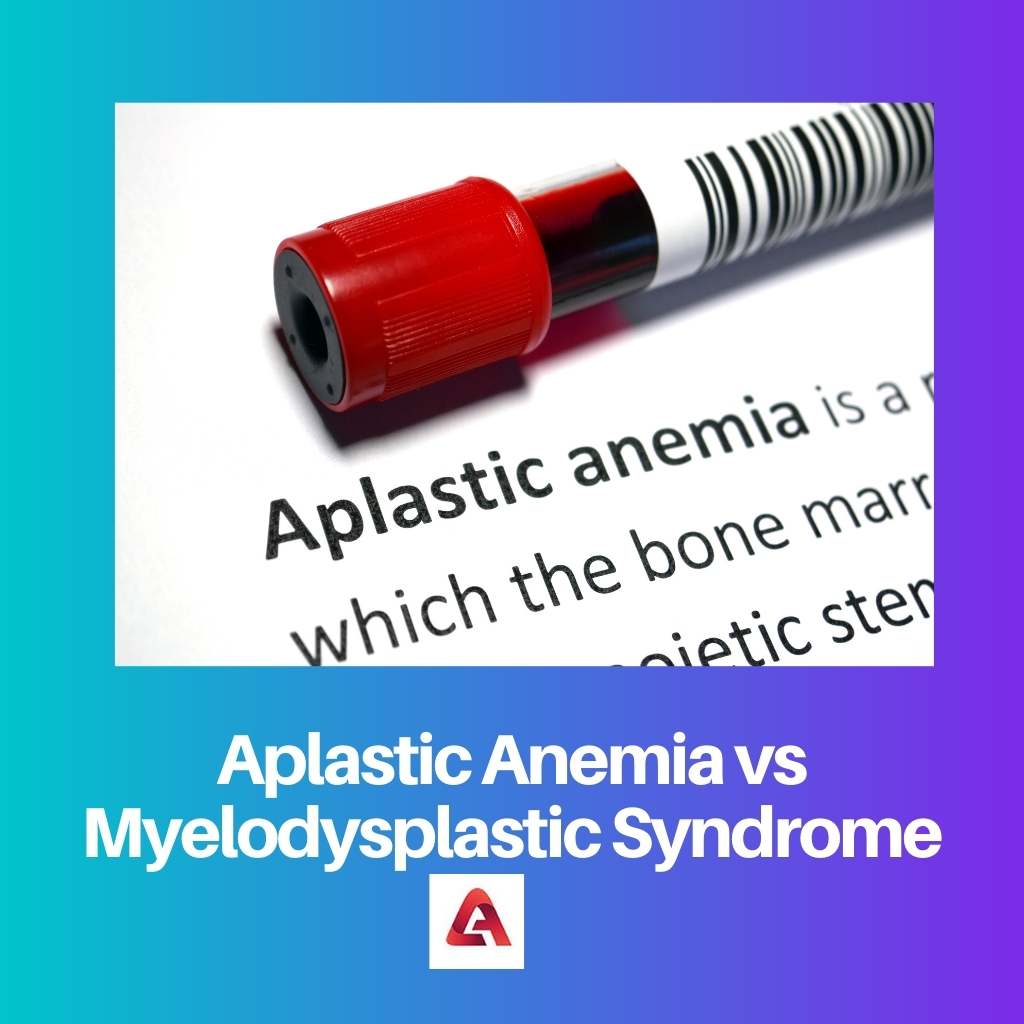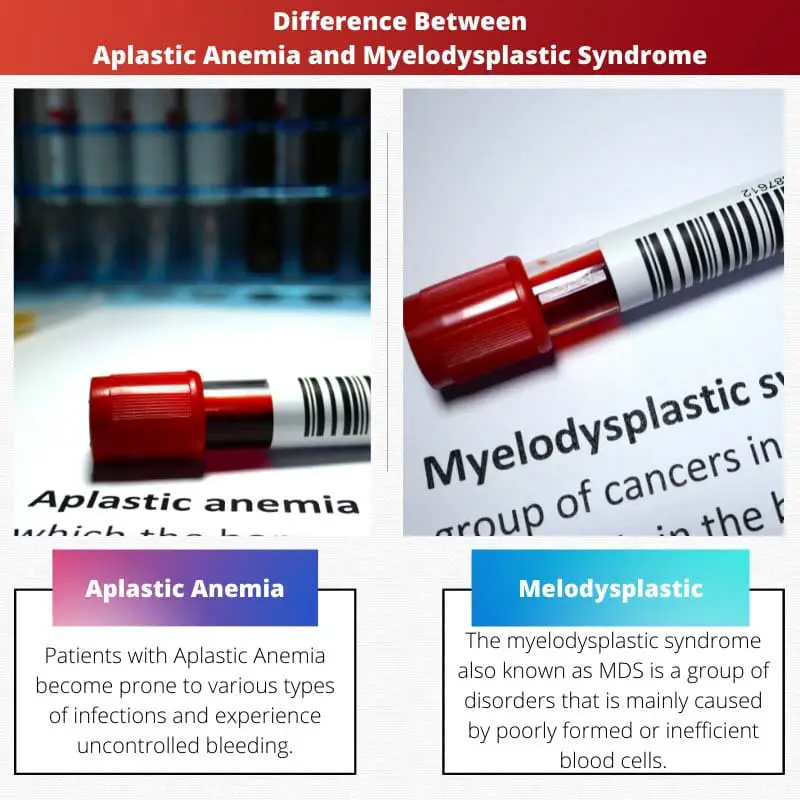Diseases which impact the blood and bone marrow are rare and serious. The bone marrow plays an essential role in the body to produce blood cells.
Two common diseases which affect the bone marrow or the blood cells are Aplastic Anemia and Myelodysplastic Syndrome.
Both diseases seem similar but have distinct differences.
Key Takeaways
- Aplastic anemia is a condition where the bone marrow stops producing blood cells, whereas myelodysplastic syndrome is a group of conditions where blood cell production is abnormal.
- Aplastic anemia is mostly caused by exposure to toxins or radiation, while the exact cause of the myelodysplastic syndrome is unknown.
- The treatment for aplastic anemia involves bone marrow transplant or immunosuppressive therapy, whereas treatment for myelodysplastic syndrome involves blood transfusions or chemotherapy.
Aplastic Anemia vs Myelodysplastic Syndrome
The difference between aplastic anaemia and myelodysplastic syndrome is that Aplastic Anemia is a medical condition in which the body stops producing new blood cells, while Myelodysplastic Syndrome is a group of disorders that is mainly caused by poorly formed or inefficient blood cells.

Patients with Aplastic Anemia become prone to various types of infections and experience uncontrolled bleeding.
The disease can be mild or severe, and the symptoms may occur suddenly or slowly over time. It can be diagnosed by bone marrow biopsy.
While Patients with myelodysplastic syndrome do not recover completely, the medications and treatment procedures slow the disease and prevent further complications.
It can be diagnosed by full blood count, examination of blood film, blood tests, bone marrow examination, cytogenetics, and flow cytometry.
Comparison Table
| Parameters of Comparison | Aplastic Anemia | Myelodysplastic Syndrome |
|---|---|---|
| Causes | Immune system attacking stem cells, radiation and chemotherapy treatments, drugs, toxic chemicals, autoimmune disorders, viral infections like cytomegalovirus, hepatitis, parvovirus B19, and various other factors | History of exposure to chemotherapy or regular exposure to toxic and harmful chemicals |
| Symptoms | Extreme fatigue, skin rashes, pale skin, bleeding nose, bleeding gums, shortness of breath, frequent infections, irregular heart rate or rapid heart rate, uncontrollable or prolonged bleeding, dizziness, fever and headache | Extreme fatigue, frequent infections or leukopenia due to low white blood cells, paleness in the skin which is known as pallor and is due to low red blood cells, pinpoint-sized red spots which are formed due to bleeding, and easy bruising of the skin which is known as petechiae and is caused due to low blood platelet count |
| Diagnostic method | Bone marrow biopsy | Full blood count, examination of blood film, blood tests, bone marrow examination, cytogenetics, flow cytometry, copper deficiency, and virtual karyotyping |
| Treatment | Chemotherapy, targeted therapy, radiotherapy or even stem cell transplant or bone marrow transplant | Medications, supportive care, bone marrow transplant or stem cell transplantation |
| Prevention | Avoiding exposure to toxic chemicals like organic solvents, insecticides, paint remover, herbicides | Avoiding exposure to cancer-causing chemicals of industries, and avoiding exposure to various kinds of radiations |
What is Aplastic Anemia?
Aplastic anaemia is a medical condition in which the body stops producing new blood cells. It is a rare as well as a serious medical condition and can affect any age group of the population.
The patients become prone to various types of infections and experience uncontrolled bleeding. The disease can be mild or severe, and the symptoms may occur suddenly or slowly over time.
The stem cells in the bone marrow are damaged in aplastic anaemia. This makes the bone marrow empty or contains just a few blood cells.
The main cause of aplastic anaemia is from the immune system, which attacks the stem cells of the bone marrow.
The stem cells of the bone marrow play a vital role in producing three major blood cells: white cells, red cells, and blood platelets.
Most of the patients diagnosed with aplastic anaemia have a 5-year survival rate. There are over 5 lakhs of death due to plastic amenia, and the report was conducted by a survey in 2015.
The symptoms of aplastic anaemia are extreme fatigue, skin rashes, pale skin, bleeding nose, bleeding gums, shortness of breath, frequent infections, irregular heart rate or rapid heart rate, uncontrollable or prolonged bleeding, dizziness, fever, and headache.
The medical condition can be short-lived or can even become chronic. It has the potential to become severe and even fatal in some cases.
Aplastic anaemia can be treated through medications or blood transfusions. Some cases may even require a stem cell transplant, also known as a bone marrow transplant.
What is Myelodysplastic Syndrome?
The myelodysplastic syndrome, also known as MDS, is a group of disorders that is mainly caused by poorly formed or inefficient blood cells.
Patients with myelodysplastic syndrome do not recover completely, but the medications and treatment procedures slow the disease and prevent further complications.
Disruption in responding material disruption in the spongy material, which is present inside the bones, hampers the formation of blood cells and is the main cause of myelodysplastic syndrome.
Some major causes are therapy treatments for cancer like radiation or chemotherapy or regular exposure to harmful and toxic chemicals.
The symptoms are extreme fatigue, frequent infections or leukopenia due to low white blood cells, paleness in the skin which is known as pallor and is due to low red blood cells, pinpoint-sized red spots which are formed due to bleeding, and easy bruising of the skin which is known as petechiae and is caused due to low blood platelet count.
The myelodysplastic syndrome has several subtypes, including single lineage dysplasia, multilineage dysplasia, isolated del (5q) abnormality of the chromosome, ring sideroblasts, and myelodysplastic syndrome with excess blasts.
People who are older than 60-65 are most vulnerable to myelodysplastic syndrome.
The Disorder can cause other complications like anaemia, uncontrollable bleeding, recurrent infections, or increased risk of cancer.
Main Differences Aplastic Anemia and Myelodysplastic Syndrome
- In aplastic Anemia, the body stops producing new blood cells, while in Myelodysplastic Syndrome, the body produces poorly formed or inefficient blood cells.
- Aplastic Anemia affects mostly children and younger adults, while people over 60 are most vulnerable to Myelodysplastic Syndrome.
- The survival rate of Aplastic Anemia is 5 years, while the survival rate of Myelodysplastic Syndrome is 2.5 years.
- The bone marrow in patients with Aplastic Anemia has hyperplastic pockets, while the bone marrow in patients with Myelodysplastic Syndrome does not have any hyperplastic pockets.
- Some cases of Aplastic anemia are hereditary, while Myelodysplastic Syndrome cannot be inherited.

- https://ashpublications.org/blood/article-abstract/102/3/916/17341
- https://ashpublications.org/hematology/article-abstract/2011/1/84/96999

The treatment and diagnosis for each condition are complex and contrast a lot, truly fascinating. It’s good to see the differences clearly outlined.
Yes, the complexities of each disease are fascinating to explore, and always good to learn more.
Agreed, the specifics of each diagnosis and treatment are intriguing.
It’s alarming to see the severity of these diseases, the comparison table helps understand some of the differences but doesn’t make them any less worrying.
It seems like aplastic anemia and myelodysplastic syndrome share some symptoms, but their causes and treatments are quite different. Can’t believe there were 500,000 deaths from aplastic anaemia in 2015.
Yes, the number is shocking. These diseases are more serious than people realize.
The comparison table is very useful, gives a clear picture of the differences, which is very helpful. It’d be interesting to know more about the causes of each disease.
It definitely helps to understand the key points between the two diseases.
I agree, the table is a great addition to the article.
This article is very informative, it managed to help me understand the differences between the diseases and the proper treatment for each. It is surprising that myelodysplastic syndrome has a lower survival rate than aplastic anemia.
The information provided is truly enlightening, it has proven to be an interesting read.
I agree with you, the article does an excellent job of pointing out the key differences between the diseases.
Aplastic Anemia and Myelodysplastic Syndrome have some similarities, but it’s important to see each one as a serious and distinct illness. It is great to see this article shedding some light into this matter.